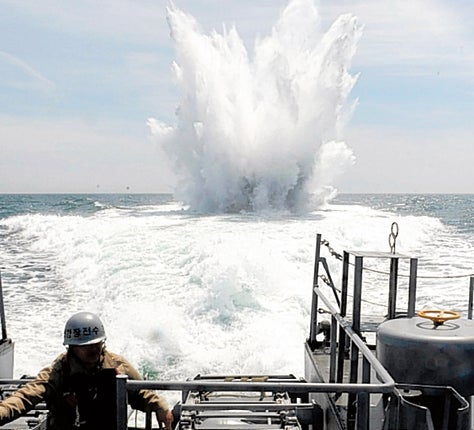Seoul flexes muscles in warning to North Korea

Your support helps us to tell the story
From reproductive rights to climate change to Big Tech, The Independent is on the ground when the story is developing. Whether it's investigating the financials of Elon Musk's pro-Trump PAC or producing our latest documentary, 'The A Word', which shines a light on the American women fighting for reproductive rights, we know how important it is to parse out the facts from the messaging.
At such a critical moment in US history, we need reporters on the ground. Your donation allows us to keep sending journalists to speak to both sides of the story.
The Independent is trusted by Americans across the entire political spectrum. And unlike many other quality news outlets, we choose not to lock Americans out of our reporting and analysis with paywalls. We believe quality journalism should be available to everyone, paid for by those who can afford it.
Your support makes all the difference.South Korean warships fired guns and dropped anti-submarine bombs in a large-scale military exercise yesterday, a week after Seoul accused North Korea of shooting a torpedo which sank a navy frigate in March.
The military pushed ahead with the show of force despite warnings from the North that the exercise would bring the peninsula to the brink of war.
North Korea's reaction was swift. Its military declared in a statement carried by the state news agency that it would scrap accords with the South designed to prevent armed clashes at their maritime border, including the cutting of a military hotline.
It also warned of "prompt physical strikes" if any South Korean ships enter what it says are its waters in a disputed area off the west coast of the peninsula.
A multinational team of investigators announced last week that a North Korean torpedo sank the Cheonan on 26 March, killing 46 sailors. Seoul announced a series of punitive measures, including slashing trade and resuming anti-Pyongyang propaganda over radio and loudspeakers aimed at the North. North Korea has denied attacking the ship, which sank near disputed western waters where the Koreas have fought three bloody sea battles since 1999.
Inter-Korean political and economic ties have been steadily deteriorating since the February 2008 inauguration of South Korean President Lee Myung-bak, who vowed a tougher line on the North and its nuclear program. The sinking of the Cheonan has returned military tensions – and the prospect of armed conflict – to the fore. Off the west coast, 10 South Korean warships, including a 3,500-ton destroyer, fired artillery and other guns and dropped anti-submarine bombs during a one-day exercise to boost readiness, the navy said.
South Korea also is planning two major military drills with the US by July in a display of force intended to deter future aggression by North Korea, according to South Korea's Joint Chiefs of Staff.
Gen Walter Sharp, chief of the 28,500 American troops in South Korea, said the United States, South Korea and other members of the UN Command "call on North Korea to cease all acts of provocation and to live up with the terms of past agreements, including the armistice agreement".
The US fought on the South Korean side during the 1950-53 Korean War, which ended in an armistice, not a peace treaty. North Korea has long demanded a permanent peace agreement. The prospect of another eruption of serious fighting has been constant on the Korean peninsula since the Korean War ended. But it had been largely out of focus in the past decade as North and South Korea took steps to end enmity and distrust, such as launching joint economic projects and holding two summits. The sinking of the warship, however, clearly caught South Korea off guard.
Join our commenting forum
Join thought-provoking conversations, follow other Independent readers and see their replies
Comments